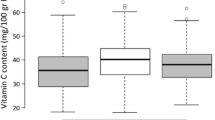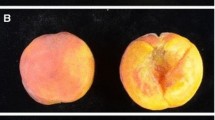Abstract
Background
The appearance quality of the eggplant (Solanum melongena L.) fruit is an important trait that influences its commercial value. It is known that quality traits such as anthocyanin composition and fruit surface pattern are categorical and are inherited simply. However, research examples of gene mapping for the composition (anthocyanin accumulation profile) and the surface pattern in eggplant fruit are limited.
Methods and results
To map loci for these traits including the accumulation profiles of two anthocyanins, a widely spreading anthocyanin, delphinidin 3-(p-coumaroyl) rutinoside-5-glucoside (nasunin), and the relatively rare delphinidin 3-glucoside (D3G), we used two F2 intracrossed populations (LWF2 and N28F2). For the LWF2 population, mapping was achieved by reconstructing the linkage map created by Fukuoka et al. [1]. In the case of the N28F2 population, we constructed a linkage map consisting of 13 linkage groups using 238 simple sequence repeats, 75 single-nucleotide polymorphisms. Using the two F2 populations, the nasunin accumulating profile, the striped pattern on the fruit surface, the colors of flowers, fruit, and calyxes, and the D3G accumulating profile were genetically mapped. Furthermore, by utilizing the eggplant reference genome information, mutations in the causative candidate genes for those loci were identified.
Conclusion
Overall, the results of this study suggest that inactivation of key enzymes of anthocyanin metabolism and the gene orthologous to the tomato u gene are potential causes of observed variety in eggplant appearance traits.



Similar content being viewed by others
References
Fukuoka H, Miyatake K, Nunome T, Negoro S, Shirasawa K, Isobe S et al (2012) Development of gene-based markers and construction of an integrated linkage map in eggplant by using Solanum orthologous (SOL) gene sets. Theor Appl Genet 125(1):47–56. https://doi.org/10.1007/s00122-012-1815-9
FAO (2019) Faostat. Food and agriculture organization of the united nations. http://faostat.fao.org
Ensminger AH, Ensminger ME, Konlande JE, Robson JR (1994) Eggplant (Aubergine) Solanum melongena. Foods and nutrition encyclopedia, 2nd edn, vol 1. CRC Press, Boca Raton, pp 646–649
Daunay M-C (2007) Eggplant. In: Prohens J, Nuez F (eds) Vegetables II: Fabaceae, Liliaceae, Solanaceae, and Umbelliferae. Springer, New York, pp 163–220
Noda Y, Kneyuki T, Igarashi K, Mori A, Packer L (2000) Antioxidant activity of nasunin, an anthocyanin in eggplant peels. Toxicology 148(2–3):119–123. https://doi.org/10.1016/s0300-483x(00)00202-x
Matsubara K, Kaneyuki T, Miyake T, Mori M (2005) Antiangiogenic activity of nasunin, an antioxidant anthocyanin, in eggplant peels. J Agric Food Chem 53(16):6272–6275. https://doi.org/10.1021/jf050796r
Ichiyanagi T, Terahara N, Rahman MM, Konishi T (2006) Gastrointestinal uptake of nasunin, acylated anthocyanin in eggplant. J Agric Food Chem 54(15):5306–5312. https://doi.org/10.1021/jf060238s
Azuma K, Ohyama A, Ippoushi K, Ichiyanagi T, Takeuchi A, Saito T et al (2008) Structures and antioxidant activity of anthocyanins in many accessions of eggplant and its related species. J Agric Food Chem 56(21):10154–10159. https://doi.org/10.1021/jf801322m
Zhang Y, Hu Z, Chu G, Huang C, Tian S, Zhao Z et al (2014) Anthocyanin accumulation and molecular analysis of anthocyanin biosynthesis-associated genes in eggplant (Solanum melongena L.). J Agric Food Chem 62(13):2906–2912. https://doi.org/10.1021/jf404574c
He YJ, Chen H, Zhou L, Liu Y, Chen HY (2019) Comparative transcription analysis of photosensitive and non-photosensitive eggplants to identify genes involved in dark regulated anthocyanin synthesis. BMC Genomics 20(1):678. https://doi.org/10.1186/s12864-019-6023-4
Honda T, Zushi K, Matsuzoe N (2012) Inheritance of anthocyanin pigment and photosensitivity in eggplant (Solanum melongena L.) fruit. Environ Control Biol 50(1):75–80. https://doi.org/10.2525/ecb.50.75
Tigchelaar EC, Janick J, Erickson HT (1968) The genetics of anthocyanin coloration in eggplant (Solanum melongena L.). Genetics 60(3):475–491
Barchi L, Lanteri S, Portis E, Vale G, Volante A, Pulcini L et al (2012) A RAD tag derived marker based eggplant linkage map and the location of QTLs determining anthocyanin pigmentation. PLoS ONE 7(8):e43740. https://doi.org/10.1371/journal.pone.0043740
Liu Y, Tikunov Y, Schouten RE, Marcelis LFM, Visser RGF, Bovy A (2018) Anthocyanin biosynthesis and degradation mechanisms in Solanaceous vegetables: a review. Front Chem 6:52. https://doi.org/10.3389/fchem.2018.00052
Stommel JR, Dumm JM (2015) Coordinated regulation of biosynthetic and regulatory genes coincides with anthocyanin accumulation in developing eggplant fruit. J Am Soc Hortic Sci 140(2):129–135. https://doi.org/10.21273/Jashs.140.2.129
Docimo T, Francese G, Ruggiero A, Batelli G, De Palma M, Bassolino L et al (2015) Phenylpropanoids accumulation in eggplant fruit: characterization of biosynthetic genes and regulation by a MYB transcription factor. Front Plant Sci 6:1233. https://doi.org/10.3389/fpls.2015.01233
Tian S, Li L, Wei M, Yang F (2019) Genome-wide analysis of basic helix-loop-helix superfamily members related to anthocyanin biosynthesis in eggplant (Solanum melongena L.). PeerJ 7:e7768. https://doi.org/10.7717/peerj.7768
Doganlar S, Frary A, Daunay MC, Lester RN, Tanksley SD (2002) Conservation of gene function in the solanaceae as revealed by comparative mapping of domestication traits in eggplant. Genetics 161(4):1713–1726
Nunome T, Negoro S, Kono I, Kanamori H, Miyatake K, Yamaguchi H et al (2009) Development of SSR markers derived from SSR-enriched genomic library of eggplant (Solanum melongena L.). Theor Appl Genet 119(6):1143–1153. https://doi.org/10.1007/s00122-009-1116-0
Hirakawa H, Shirasawa K, Miyatake K, Nunome T, Negoro S, Ohyama A et al (2014) Draft genome sequence of eggplant (Solanum melongena L.): the representative solanum species indigenous to the old world. DNA Res 21(6):649–660. https://doi.org/10.1093/dnares/dsu027
de Givry S, Bouchez M, Chabrier P, Milan D, Schiex T (2005) CARHTA GENE: multipopulation integrated genetic and radiation hybrid mapping. Bioinformatics 21:1703–1704
Kosambi DD (1944) The estimation of map distance from recombination values. Ann Eugen 12:172–175
Barchi L, Pietrella M, Venturini L, Minio A, Toppino L, Acquadro A et al (2019) A chromosome-anchored eggplant genome sequence reveals key events in Solanaceae evolution. Sci Rep 9(1):11769. https://doi.org/10.1038/s41598-019-47985-w
Voorrips RE (2002) MapChart: software for the graphical presentation of linkage maps and QTLs. J Hered 93(1):77–78
Broman KW, Sen S (2009) A guide to QTL mapping with R/qtl. Statistics for biology and health. Springer, New York
Barchi L, Rabanus-Wallace MT, Prohens J, Toppino L, Padmarasu S, Portis E et al (2021) Improved genome assembly and pan-genome provide key insights into eggplant domestication and breeding. Plant J 107:579–596. https://doi.org/10.1111/tpj.15313
Brugliera F, Barri-Rewell G, Holton TA, Mason JG (1999) Isolation and characterization of a flavonoid 3’-hydroxylase cDNA clone corresponding to the Ht1 locus of Petunia hybrida. Plant J 19(4):441–451. https://doi.org/10.1046/j.1365-313x.1999.00539.x
Yamazaki M, Yamagishi E, Gong Z, Fukuchi-Mizutani M, Fukui Y, Tanaka Y et al (2002) Two flavonoid glucosyltransferases from Petunia hybrida: molecular cloning, biochemical properties and developmentally regulated expression. Plant Mol Biol 48(4):401–411. https://doi.org/10.1023/a:1014043214943
Powell AL, Nguyen CV, Hill T, Cheng KL, Figueroa-Balderas R, Aktas H et al (2012) Uniform ripening encodes a Golden 2-like transcription factor regulating tomato fruit chloroplast development. Science 336(6089):1711–1715. https://doi.org/10.1126/science.1222218
Acknowledgements
We thank Tetsuo Izumi, Hanako Maeda, and Kimiko Tanaka of the Institute of Vegetable and Tea Science, National Agriculture and Food Research Organization of Japan for their technical assistance.
Funding
The authors declare that no funds, grants, or other support were received during the preparation of this manuscript.
Author information
Authors and Affiliations
Contributions
AO, HY, KM, TN, TS, and HF conceived the project and designed the experiments. HY, AO, KM, and HF performed phenotypic analysis. AO, SN, KM, TN, and HF acquired the plant materials and performed DNA extraction and genotyping. AO performed statistical analyses and wrote the manuscript. All authors reviewed and approved the manuscript.
Corresponding author
Ethics declarations
Conflict of interest
The authors declare that they have no conflict of interest.
Ethical approval
No experiments performed as part of this study involved human or animal participants.
Competing interests
The authors have no relevant financial or non-financial interests to disclose.
Additional information
Publisher’s Note
Springer Nature remains neutral with regard to jurisdictional claims in published maps and institutional affiliations.
Electronic supplementary material
Below is the link to the electronic supplementary material.
Rights and permissions
About this article
Cite this article
Ohyama, A., Yamaguchi, H., Miyatake, K. et al. Genetic mapping of simply inherited categorical traits, including anthocyanin accumulation profiles and fruit appearance, in eggplant (Solanum melongena). Mol Biol Rep 49, 9147–9157 (2022). https://doi.org/10.1007/s11033-022-07737-y
Received:
Accepted:
Published:
Issue Date:
DOI: https://doi.org/10.1007/s11033-022-07737-y




